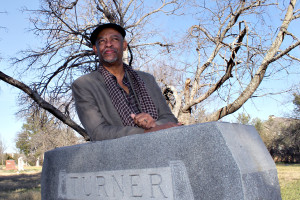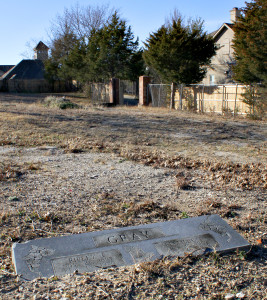
By David Wilfong, NDG Contributing Writer
If a person stands atop the high LBJ/Tollway overpass, looking out across the North Dallas horizon, they would see an endless vista carpeted by large brick homes, condos and apartment buildings, but it wasn’t always this way.
The area near that interchange, not so long ago, was a landscape of rolling hills, creeks, dense areas of trees; and small communities nestled north of what was even then called “Big D”.
In the mix of pathways running around Valley View and the Galleria is Alpha Road, which is a well-known landmark to pretty much everyone who has spent any significant time navigating the streets of Dallas. But as George Keaton, Jr., a retired educator who now devotes his time to preserving and sharing the history of African Americans in the DFW area, will happily point out, it is more than just a name.
Alpha was a community, an unincorporated town that officially ceased to exist in 1987, but had begun being swallowed up by the Metroplex some years before that. It was founded by former slaves shortly after the Civil War.
At the corner of Preston Rd. and Spring Valley Rd. sits “Caminos del Misionero” a small church which provides Christian services in Spanish.
“That was the original site of Mt. Pisgah Baptist Church,” Keaton says driving by on Preston Rd. “It’s a Hispanic church now, but it was originally a black congregation. Back then, this (Preston) was nothing more than a two-lane dirt road, or maybe tar by then.”
Mt. Pisgah is still alive and well, having recently moved from Webbs Chapel to a new home at 1020 Sherman St. in Richardson. But it, like many churches in the area, owes its beginnings to a small community that was once considered separate from the big city.
Keaton is the executive director and founder of Remembering Black Dallas, Inc. (RBD), which focuses on historical research, preservation, education and genealogy. RBD meets on the fourth Saturday of every month for various presentations having to do with local history of interest to African American culture. In addition, Keaton often conducts tours of the historic landmarks in the area.

“I’ve had people come from all over the world,” Keaton says of his tour groups. “Often there’ll be families in town when someone is getting married or something, but I’ve also had an entire bus full of people from Africa take the tour.”
Keaton attracts new members and tour clients from his website (www.rbdallas.com), through his Facebook page and by word of mouth as people begin to take more interest in Dallas’ early African American community.
The church being central to the early black culture in North Texas, there are other historic houses of worship in the vicinity. Near Anne Frank Elementary, completely surrounded by upscale North Dallas homes, White Rock Chapel still sits, and is still attended by a small congregation. Most of the original congregation moved to become what is now Christian Chapel C.M.E., Temple of Faith at 14120 Noel Rd.
White Rock was another settlement of former slaves from the Coit, Caruth and Obier plantations, and the first church was established in 1884. Though hidden by large homes, White Rock Creek still flows just down the hill from the church.
Keaton pulls his car to a small drive that dead-ends between two private homes.
“There used to be a bridge here,” Keaton recalls. “This is where people would cross the creek to get to the cemetery. The original church was on the other side, but then they had a flood. Some people died and they moved the church over to this side to higher ground.”
For Keaton, these are more than just historic sites and remnants of a culture he hopes to keep alive; this is the landscape of his youth, now mostly hidden by modern structures.
Leaving the chapel, he weaves through a maze of city streets, working his way around to the other side of the creek. There, he drives towards what seems like a small service alley behind a sprawling apartment complex. But the small alley keeps going, behind apartments, up a hill, and finally to a gate that opens between wooden fencing.
Inside is the White Rock Garden of Memories Cemetery. The vast majority of the graves there belong to old black Dallas families, though there is a very small section of white families buried in the back section. Keaton explains that it was originally a white cemetery, but that black families purchased the land next to it, and then expanded their lot at a later date. Headstones dating back to the 19th century are abundant throughout.
Keaton’s own family is buried there, and while telling the story he steals a few moments to clear off the brush that is encroaching on the tombstones of family members. Though the towering tops of massive apartment developments jut out above the wooden fence in almost all directions, the graveyard itself seems to keep a grip on a time when the area was rural, and the pace of life a bit slower.
Leaving the site, Keaton continues to tell the stories of even more areas of what is now one big city, each now-neighborhood with a past as a community and an origin for many of the families who still live in Dallas today.
If a person stands atop the high LBJ/Tollway overpass, looking out across the North Dallas horizon, they would see an endless vista carpeted by large brick homes, condos and apartment buildings … but there are holes in the carpet where history can still shine through, and if you know where to look, remnants of Dallas’ original African American communities still stand as a testament to the lives that were lived as one of Texas’ largest cities moved slowly toward a new social order.
If you don’t know where to look, call Keaton, and he’ll be happy to show you.





[…] Dallas area. Visit here for more info on the tour. You can read more about the organization in an article the North Dallas Gazette wrote […]